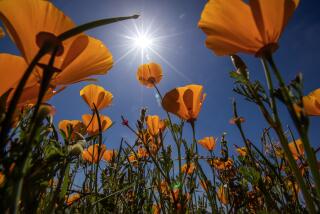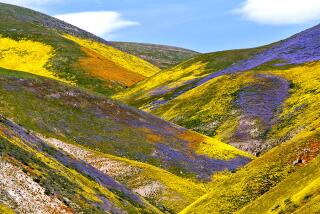The Science of Beautiful Poinsettias
In the last 20 or so years, plant breeders have really spiffed up the poinsettia. There are new creams, pale yellows and earthy oranges that go better with some interior paint schemes. Applied science has brought forth extra deep reds, sophisticated pinks and the first purple, which will debut next year.
Many kinds are now splashed or speckled with contrasting colors, or they have handsome variegated foliage. Blooms are bigger. There are even miniature ones--how about those poinsettias that you’d swear were roses--at least from a distance? The plants now last longer, and at least one new variety blooms as early as mid-November.
No wonder poinsettias have become the No. 1-selling potted plant in the United States.
It wasn’t that long ago that they looked pretty much like poinsettias in 1828 when the first U.S. ambassador to Mexico, Joel Roberts Poinsett, sent cuttings to this country. The amateur botanist and plant explorer found this fiery Mexican wildflower in the state of Taxco, where the Aztecs had long called it cuetlaxochitl, which means something like “leathery petals.”
Botanists quickly named it Euphorbia pulcherrima (“the prettiest euphorbia”), and it was soon grown on the East Coast as a greenhouse plant and acquired the common name of “poinsettia.” Blooming when days were short in midwinter, it quickly became an icon for Christmas, and by the beginning of the 20th century, lovely drawings of bright red poinsettia blooms frequently graced the season’s greeting cards.
In California, poinsettias were grown in fields for the cut-flower trade and in backyards. You can still see vintage poinsettia varieties peeking over the fences of older gardens.
Over the years, growers had made some improvements to the wild poinsettia, but it wasn’t until the 1960s that serious science was applied to find superior varieties. The first thing breeders looked for was better staying power. In the 1950s, poinsettia plants were lucky to last the week indoors. Today’s newest poinsettias easily last three to four weeks inside.
The early improvements were naturally occurring mutations, or “sports,” spotted by nurserymen with “keen eyes,” according to Ruth Kobayashi, a plant breeder working full time on improving poinsettias for the Paul Ecke Ranch in Encinitas. About 80% of the poinsettias in this country get their start at the Ecke Ranch, which mostly raises cuttings that are then sold to other nurseries, which grow them to maturity.
Kobayashi calls the colorful parts of a poinsettia “blooms,” but she points out that they are not technically flowers. They are actually “bracts” or modified leaves. The real flowers--what gets pollinated--are the tiny cup-like capsules clustered inside the circle of bright bracts.
Poinsettias are not self-pollinators. They need other poinsettias to reproduce in a natural process known as “out crossing,” according to Kobayashi, who has a doctorate in plant breeding and genetics. Out crossing greatly increases the chances for change in each generation of plants. Every single seed resulting from such a cross is going to be different, sometimes surprisingly so.
Most of the time, breeders simply give nature a helping hand. They make hundreds of crosses by hand-pollinating the individual flowers with a small brush, then raise thousands of seedlings and observe them carefully for the desired traits, such as earlier or bigger blooms, or unusual colors.
Breeders can “induce” mutations, said Kobayashi, with simple techniques, such as chemical treatment or irradiation of the seed. This can cause the doubling of chromosomes, which makes for thicker cell walls and sturdier plants. Plants with more chromosomes also are easier to cross and are more likely to sport.
Occasionally, scientists must step in and perform an “embryo rescue” when the seed for one reason or another cannot support the embryo. They remove the embryo from the seed and raise it artificially. In fact, the process of raising new plants from tiny bits of plant tissue can take place entirely in a Petri dish or glass flask--inside a tissue culture laboratory.
By carefully choosing the parents, breeders can pretty much guess what is going to be the outcome of these controlled crosses, but all this takes time and incredible patience. Franz Fruehwirth, Kobayashi’s predecessor at the Ecke Ranch, worked for 30 years to come up with the distinctive, curly ‘Winter Rose’ variety that looks like a rose at first glance.
Kobayashi makes about 500 controlled crosses a year and raises 10,000 to 20,000 seedlings in her search for improved or distinctive poinsettias. Less than 1% of these will be grown for another three or four years to see how they perform. Then the most promising go off to growers in other parts of the country for more trials.
An early benchmark in poinsettia breeding was the variety ‘Paul Nicholson,’ which was not only long-lasting but short, stiff and compact, perfect for growing in pots. In the early 1960s, it helped turn poinsettias into an indoor pot plant, instead of just a cut flower. It was followed in the mid-1960s by a variety from Europe named ‘Annette Hegg,’ which sired a whole series of poinsettias that had five or six flowering stems so they looked like a bouquet in a pot. ‘Lilo Red’ developed in the 1980s was yet another breakthrough poinsettia, with really deep-green foliage that made the whole plant appear to be healthier, followed by ‘C-1,’ with “gigantic, very elegant blooms,” according to Kobayashi.
At this point, there was no stopping poinsettias--with every improvement, their popularity grew--and in 1986, they “gently pushed chrysanthemums aside to become the No. 1 bestselling potted plant in the United States,” according to the informative “Poinsettias, the December Flower,” by Christine Anderson and Terry Tischer (Waters Edge Press, 1998). The authors point out that poinsettias pulled off this coup even though they were only sold for a two-month period each year, while their competitors are sold year-round.
In the last few years, there has been a steady stream of new and improved poinsettias, including the Freedom series, which bloom several weeks earlier, lengthening the season.
This year alone, the Ecke Ranch introduced 10 new varieties, including ‘Freedom Rose,’ ‘Cranberry Punch,’ ‘Red Velvet,’ ‘Success Coral’ and ‘Peterstar Orange.’ Next year, they will pop the first purple poinsettia on the public, one appropriately named ‘Plum Pudding.’ There are also new poinsettias with leaves shaped like holly and one with colors so complex it looks like the pink and red were applied to its creamy bracts with an airbrush.
Coming in the near future are a pink poinsettia with big, incurved, roselike bracts; a red with bracts that point upward so you can see the leaves underneath; and one with white-and-pink markings that make it look like a patchwork quilt.
It’s hard to guess what breeders like Kobayashi will come up with next, but since the Ecke Ranch test markets its newest right here in the Southland, we will be the first to see any new wrinkle.






